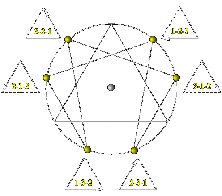





I'll use Rodney Collin's terminology here. (At different times, Ouspensky used the terms "actions" and "activities" and "triads".) The theory is that there are six fundamentally different kinds of processes (developments over time) and that all developments in time are therefore one of, or a combination of, these six basic processes.
In world 3 three there are no processes, because there is no time. In world 6 and on down, there are six processes. But where do they come from? How do they appear as fundamental aspects of this world which we are told consists of two basic laws: the law of three and the law of seven?
The six processes and the world above them are the law of seven. Relative to any particular level, the seventh process is the world that is higher than the world in which the six processes are being considered. (Higher and lower: In terms of the law of octaves, the seventh process is Do.)
As I've discussed elsewhere (see All and Everything), world 6 is derived from world 3. One way of viewing it is like this:
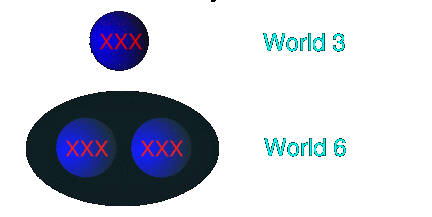
But world 3 is of a much different nature than world 6. The three laws operating in world 3 are in the same space/time, that is, there is no distinction between them in the ordinary way. From the point of view of lower worlds (and, relative to world 3, world 6 is a lower world) the three appear as one event. So seven processes might be viewed like this:

In world 6, time and space are distinct, and we first encounter process, or sequence, which requires time and space to be separately perceived. In fact, we encounter six possible sequences. World 6 is the three forces of world 3 ordered in time and space. If we assign a number to each of the three laws of world three, say "1", "2" and "3", we can combine them sequentially in only six possible orders:
1 - 2 - 3 2 - 3 - 1 3 - 1 - 2 1 - 3 - 2 3 - 2 - 1 2 - 1 - 3
These six processes are the six points of the enneagram (those points on the circle that are not points of the triangle). These six points represent the law of seven, the notes of the octave, the seventh point or note being the "seventh process", or the way the higher world appears to the one below it. In the octave, for example, the first and last note are the same note, which is the alpha and omega of the octave, containing the six possible notes or processes within it. (0)

In this written format, of course, I have to keep to theory and leave it to your personal work in a school environment to learn more about the practical nature of this idea. In the main, I'll continue to use Rodney Collin's terminology and refer to the individual components of the processes— the "1", "2", and "3", mentioned above —as "life", "matter", and "form", respectively. (The terms may well have originated with Mr. O as no doubt much of Rodney Collin's The Theory of Celestial Influence did, but it is in Collin's written work that these terms are first published.)
As we know from In Search of the Miraculous, matters are differentiated by their densities—density of vibration, or its inverse, density of matter. Active force, here called "life" has, relatively, the highest density of vibrations and lowest density of matter; passive force, here called "matter", has the lowest density of vibration and highest density of matter; and neutralizing force, "form", is intermediate between life and matter in density of both matter and energy.
So recalling the listing above of the possible processes (1-2-3, 2-3-1, and so on,), we can use that as a shorthand and say life=1, matter=2, and form=3. So 1-2-3 means life-matter-form, or, "life acting on matter to produce form". An example of this particular process is a potter making a pot: The potter (in this case life), takes the clay (matter), and shapes it into a bowl (form). Life-matter-form. 1-2-3. This does not define any object as forever acting as that force: in different processes the potter or the pot may, for example, be the "matter".
Mr O. often cautioned his students to only accept those instances of the processes as valid which were unmistakable. With this, as with other ideas of the fourth way, there is nothing to be gained and much to be lost by forcing an interpretation on an event. Let it be. Think about it, yes, but when the time comes, you will know which process something is without the need for anything but the simplest reflection.
So. Three factors, in time, can combine in six ways. These six processes, six combinations of the Three, have distinct and unique qualitative properties, which are best defined in any given situation, but some generalization is possible if we do not get too tangled in the words themselves but recognize the principles.

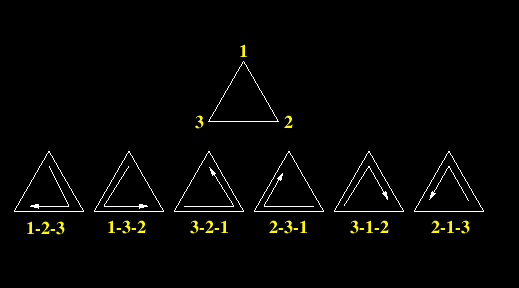
The six triangles below the top triangle represent the six processes—the label of each gives the sequence in which the forces act (and this is shown graphically with the directional arrows.)

One great triad contains the clockwise triads 1->2->3, 2->3->1, 3->1->2;
and the other great triad contains the counterclockwise triads 1->3->2, 3->2->1, 2->1->3:
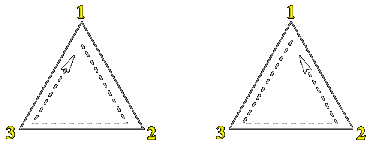
Combined into the single symbol, it looks like this:
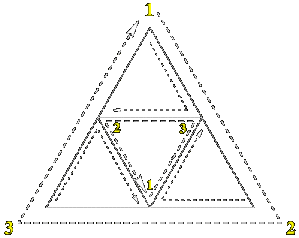
In this image we see the 1-2-3 or clockwise triad as the large, inclusive triangle, and the inner inverted triangle is the 1-3-2 or counterclockwise triangle. (We could just as well have drawn this with the counterclockwise triangle as the large triangle and the clockwise triangle as the inner central triangle.) In this case, we see that the way we have drawn it also illustrates the three processes (shown as the three corner triangles—1-2-3, 2-3-1, 3-1-2) that form the "great triad" of the outer triangle. I'll have more to say about these two great triads below.
If instead of "my" symbol we plotted the triads on the enneagram, they correspond to these points:
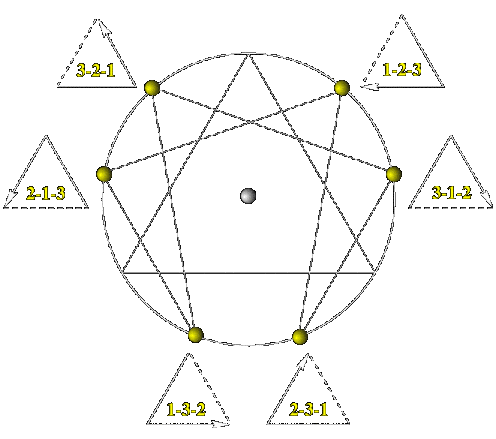
Here the left half of the diagram contains one of the great triads, the right half the other great triad. Opposites are across from each other (e.g., 1-2-3 across from 3-2-1) and the enneagram triangle itself represents the "seventh process", in which all forces act simultaneously. (1)
In the following I'll briefly discuss each of the six processes in the order in which they occur around the enneagram starting at the top right and moving clockwise. After the basic information of the six processes is discussed, I'll conclude with how these six processes operate in the two great triads.

Life, acting on matter, produces a form.
Building a house. I (life) take bricks (matter) to build the walls (form). A snail takes minerals to build a shell.
Life acts on matter to create a new form, a form which is active relative to some coarser matter and so acts on it to create a new form, etc. The result is a progressively less energetic activity.
A pendulum is a good example of the way this triad tends to spawn new triads while continuing to lose energy: Each swing of the pendulum from one side to the other is a triad, starting at the highest and most energetic point, passing through the lowest, and ending up at a point between the two. The point it ends up at is then the high point of the next triad. and so on:


Form, applied to life, results in matter.
The classic example here is the virus. Not life itself, but a form that acts on life, ultimately reducing life to matter. In human affairs, an example is a repressive government, such as the former Soviet system, that applied a form restricting the livelihood of citizens, ultimately destroying the source on which it fed. On a more psychological level, formatory mind acts with this triad: Form is applied to a new idea and the new idea is killed. (I have more to say about this triad in The Process 3-1-2.)

Matter, aided by form, is restored to life.
An estranged couple who have marriage counseling and find their marriage subsequently revitalized. A broken bone aligned with a splint grows back into its proper functioning. An infected tissue treated with an antibiotic is restored to health. (The essence type here is the loving Venusian, a high percentage of our nurses.)

Life, acting on form, produces matter.
I smash the pot. Life, that is active force, is applied to a form, resulting in the destruction of that form into constituent matter. The type is Mars, the gland is the adrenal. This is a "descending octave", because we begin with life and end with matter. Interesting to note that this stage always proceeds any real development, which should make it clear to us that "descending octave" is not a value judgment, and descending octaves are right action in the proper place.

Matter, acted on by life, becomes a form.
The food diagram is the pre-eminent representation of this triad in the human being. Pre-eminent because it includes all levels of matter refined or possibly refined within us, and shows it in a form which is simply an anthropomorphized enneagram. Regarding food, for example, the triad often begins outside of us: We first cook the potatoes or beans (potato - 2; fire - 1; cooked potato - 3), then chew it (cooked potato - 2; chewing - 1; masticated potato - 3); and so on. Or we receive a neutral visual impression - 2; we divide our attention, energizing that impression - 1; a finer hydrogen results - 3, to be wasted, used, or further refined.

Right form applied to matter brings it to life.
A Shakespeare uses mere words to create something that moves and informs people for centuries. A Leonardo mixes mere pigments and creates art capable of transmitting objective knowledge across 500 years. An anonymous Chinese sculptor forms a Buddha out of local stone that inspires receptive viewers through millennia.
A teacher brings to life a form in the presence of students. The students imitate the form first, apply it in their lives, and, if successful, create new life by the use of it. This enables them to pass on the example of the use of form on matter to create life.
The fourth way is just such a form designed to bring life. The matter it is applied to is the student. We study the system, practice the ideas, apply it to ourselves, and gradually convert it from an external set of ideas to a living teaching by living it.


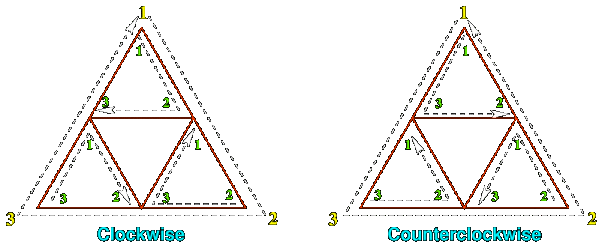
The way that processes, or triads, proceed depends on whether they are descending or ascending processes. A descending process begins at a higher energy level than it ends at, and an ascending process ends at a higher energy level than it begins at. An example of a series of descending triads is given by the Ray of Creation, where a sequence of triads of the process of growth (1-2-3) ultimately produce molecular matter from high energy particles.
In a descending process, the energy or effort required to initiate the process occurs at the beginning, and the process then proceeds mechanically. For example, the process of destruction, 1-3-2, may be exemplified by burning down a house: the active force, fire in this case, is applied to the structure, and then the triad proceeds until there is no more it can destroy.
In an ascending process, energy or effort must be supplied continually, or at repeating intervals until the process is complete. Healing a wound (2-1-3), for example, may require frequent changes of the dressing, application of antibiotics, and so on, all the while the body is patiently making repairs cell-by-cell.
When I first began to work with the six processes, I tried to find a more mnemonic form or structure to put them in so that I could better recall them without having to return to the books all the time. I tried, for example, to create a short poem I could memorize that would summarize each process in association with its sequence of forces. One result of this was that I came across the fact that the order of the processes may be seen as two different cycles, one going in a clockwise and the other in a counterclockwise direction. (Incidentally, this little story, in which I just described how I came to the two great triads that I am discussing here, is another illustration of the triad 1-2-3, the process of the growth of an idea in this case, in which I applied some effort to the matter of these processes and came out with a form or structure that I could use.)
The two great triads represent the left and right sides of the enneagram.
If we view just the great triads and their direction of flow, we see this:
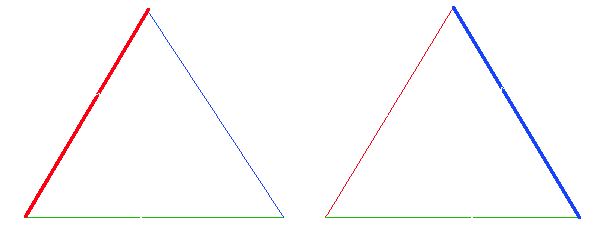
If we connect the opposite sides of these triads to the each other's top points, we get the following figure which maintains the flows of the two individual triads, yet has a single consistent flow:
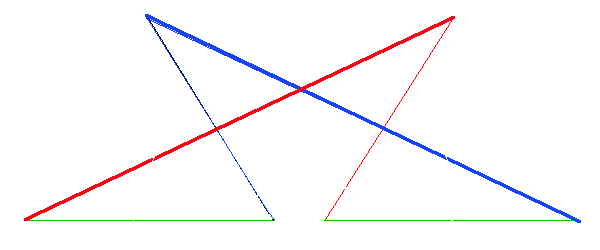
This is better recognized as the internal circulation of the enneagram:
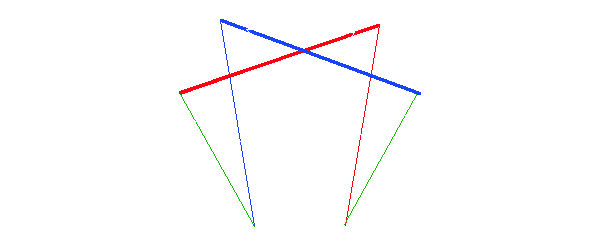

I have noticed a few things I want to mention in closing this essay. The great clockwise triad has seemed to me to have a lot to do with the processes of living things: how they grow, get ill, and get healed to grow again. This is the sequence of triads 1-2-3, 3-1-2, 2-3-1, shown as the clockwise triad or the right side of the enneagram in my drawings above.
The other great triad, the one that moves counterclockwise on the triangle, seems to me to represent necessary stages in the Work. There is destruction, there is refinement, and there is regeneration, the ultimate goal, rebirth. As I pondered this sequence, I suddenly remembered a quote from Gurdjieff, at the beginning of his Life is real only then, when "I am" in which he described his intentions with each of his three series of books:
First Series: To destroy, mercilessly, without any compromises whatsoever, in the mentations and feelings of the reader, the beliefs and views, by centuries rooted in him, about everything existing in the world. Second Series: To acquaint the reader with the material required for a new creation and to prove the soundness and good quality of it. Third Series: To assist the arising, in the mentation and in the feelings of the reader, of a veritable, nonfantastic representation not of that illusory world which he now perceives, but of the world existing in reality.This sequence seems to closely resemble the sequence of the counterclockwise triads: destruction, refinement, regeneration. I think these three stages, in this order, are required to progress in this work. We have to remove and destroy a lot of the old wrong work, allowing for the presence and development of new work, ultimately to achieve something personal and real. In a certain way, I think the historical figures of Gurdjieff, Ouspensky, and Collin illustrate this sequence. While each had, of course, to go through all stages, their relation in time and their unique expressions of this work in their lives again seems to show this very sequence of destruction, refinement, and the new perception. I cannot quite accept it as coincidence that the three processes of this great triad, in that order, are also the processes that map to each of these three great men's essence type.

Note 0- Relative to the octave, each note represents the specific, named process. Within the octave, each note passes to the next by means of a process, the process depending on the octave. In the octave of digestion or refinement seen in the food diagram, for example, it is the same process between each note.

All pages © Copyright John Raithel